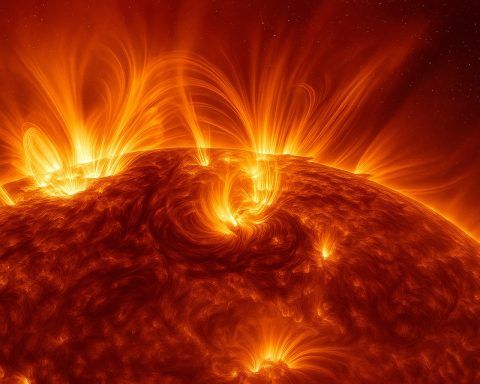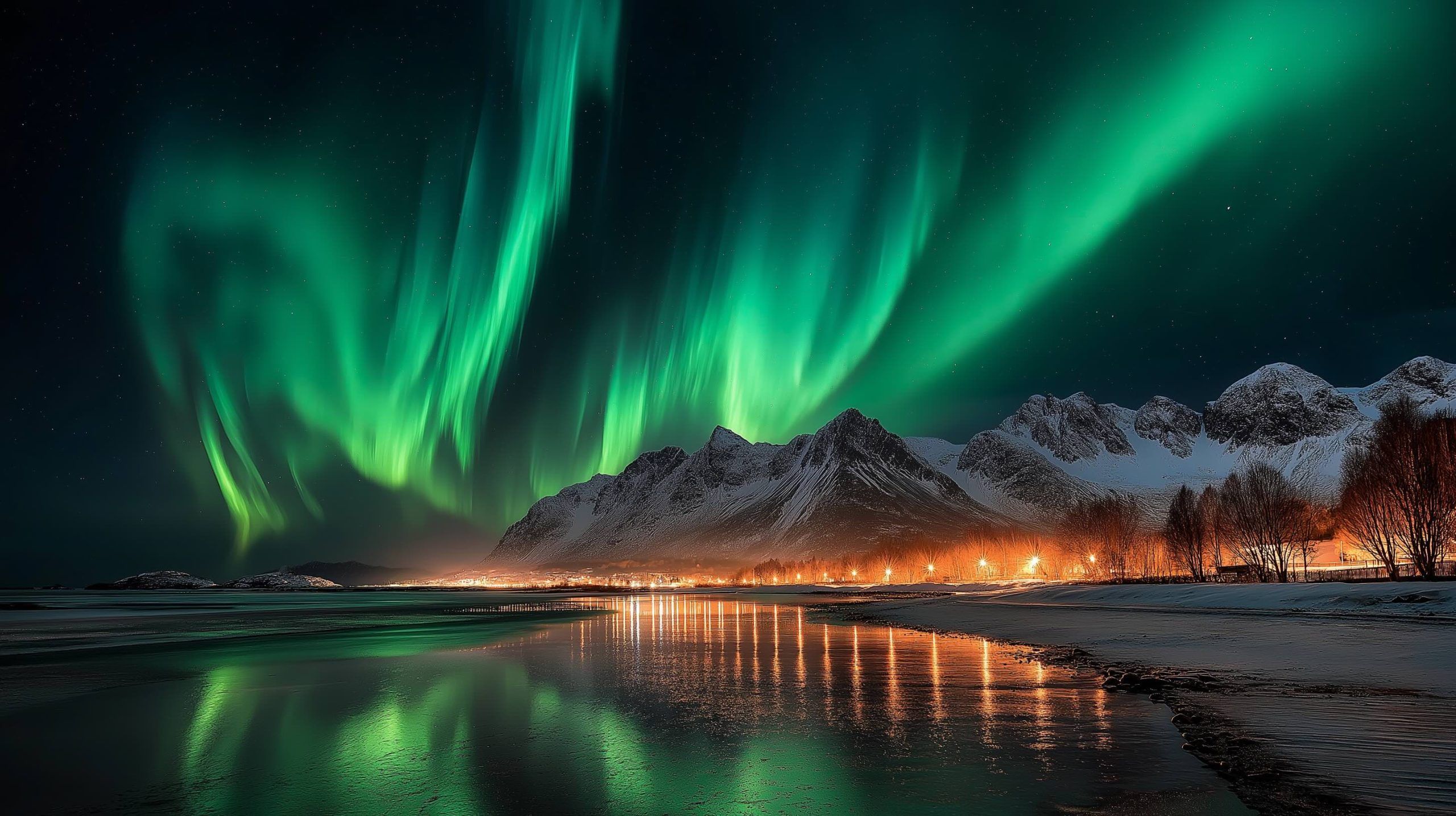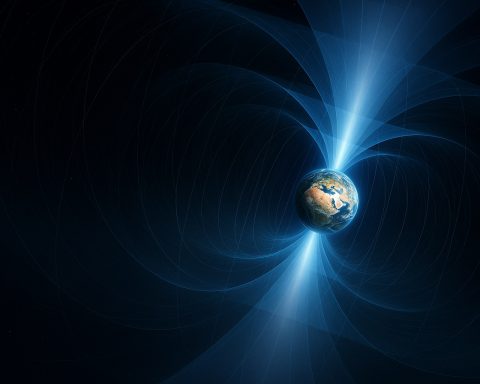- NOAA confirms G4 (Severe) geomagnetic storm levels were reached early today; additional strong-to-severe episodes remain possible. [1]
- A powerful X5.1 solar flare on Nov. 11 from sunspot region AR4274 drove today’s storm after causing R3 (“strong”) radio blackouts across parts of Africa and Europe yesterday. [2]
- Auroras exploded across the Northern Hemisphere overnight—with reports as far south as Mexico and the U.S. Gulf Coast—and could intensify again tonight if a third CME arrives. [3]
- Regional agencies report significant impacts: the UK logged local G5 (K=9) bursts and its largest induced geoelectric field on record since 2012; Australia’s forecasters expect G4 with a chance of G5. [4]
- Storminess may linger into Nov. 13–14 as multiple CMEs continue to interact with Earth’s magnetic field. [5]
What’s happening now
The U.S. National Oceanic and Atmospheric Administration (NOAA) reports that G4 (Severe) geomagnetic storm levels were reached at 01:20 UTC on Nov. 12 and that G1–G4 conditions could continue overnight, driven by successive coronal mass ejections (CMEs). [6]
In a midday update, NOAA added that strong (G3) storming has persisted and that the Nov. 11 CME is still expected to keep elevated storm levels going into Nov. 14 (UTC)—meaning another night or two of aurora potential and intermittent space‑weather impacts. [7]
Across the Atlantic, the UK Met Office notes that two CMEs arriving late Nov. 11/early Nov. 12 delivered several G4 periods this morning, with an additional CME from the Nov. 11 flare likely to intensify conditions later today. [8]
The spark: 2025’s strongest solar flare (so far)
On Nov. 11, sunspot AR4274 unleashed an X5.1-class solar flare—the most powerful of 2025 to date and the strongest since Oct. 2024. The blast peaked at 10:04 UTC, triggering R3 (strong) shortwave radio blackouts across Africa and Europe. The flare launched a fast CME toward Earth, stacked atop CMEs from Nov. 9 (X1.7) and Nov. 10 (X1.2). Together, these eruptions set up today’s severe geomagnetic storm. [9]
NOAA confirmed the X5.1 R3 event in an advisory on Tuesday, underscoring the flare’s significance in this solar cycle. [10]
Where the aurora is visible
- North America & Europe: A severe (G4) storm lit up skies overnight (Nov. 11–12) with reports and images from Canada, the U.S., and as far south as Mexico, and widespread displays across Europe. A further round is possible tonight if the third CME arrives. [11]
- United Kingdom: The British Geological Survey (BGS) reports G4 globally, local G5 (K=9) spikes at UK observatories, and the largest induced geoelectric field recorded in the UK since 2012—conditions that often push auroras deep into the country. [12]
- Australia & New Zealand: The Australian Bureau of Meteorology’s Space Weather Service expects G4 today with a chance of G5, and local media/forecasters are flagging aurora australis visibility potentially as far north as Sydney and Perth under clear, dark skies. [13]
Impacts to watch
- HF/shortwave radio & aviation: Expect HF fadeouts and patchy communications on the sunlit side during strong flares, and high‑latitude HF disruption during geomagnetic peaks. Yesterday’s flare already delivered R3 radio blackouts across parts of Africa and Europe. [14]
- Navigation & timing (GPS/GNSS): Position errors and scintillation can occur, especially at high latitudes and during rapid geomagnetic changes. (NOAA notes GNSS vulnerability during geomagnetic storms.) [15]
- Satellites & LEO operations: Increased atmospheric drag and surface charging risks rise during sustained geomagnetic activity—UK authorities cite strong geoelectric conditions today. [16]
- Power grids: Geomagnetically induced currents (GICs) can stress long conductors. BGS reports record geoelectric field levels (since 2012) in the UK during this storm—an indicator grid operators monitor closely. [17]
Context—Asia: Ahead of this week’s activity, Taiwan’s Central Weather Administration issued a geomagnetic storm alert (Nov. 6) warning of possible satnav/radio disturbances, false alarms in protective systems, and increased drag on low‑Earth‑orbit satellites—the same classes of impacts relevant today. [18]
How we got here: a train of CMEs
This week’s space weather began with X‑class flares on Nov. 9 (X1.7) and Nov. 10 (X1.2), each launching CMEs. The X5.1 flare added a faster, more energetic CME on Nov. 11. Forecasts from NOAA and the Met Office describe multiple arrivals and the potential for stacking/merging CME effects, which enhance storm intensity and duration. NOAA’s official watch sequence (G2 Nov. 11 → G4 Nov. 12 → G3 Nov. 13) captured this escalation. [19]
Outlook: Tonight and the next 48 hours
- Tonight (Nov. 12–13): NOAA and partner agencies say strong to severe storming is still possible if the Nov. 11 CME fully couples with Earth’s magnetic field. Keep alerts on and batteries charged. [20]
- Through Nov. 14 (UTC):Elevated geomagnetic activity may persist, keeping aurora chances alive and technical impacts intermittent. [21]
How to see (and photograph) the aurora tonight
- Go dark & look north/south: In the Northern Hemisphere, face north; in the Southern, face south—with a clear view to the horizon. (Reports last night reached Mexico; Australia is on alert for Sydney/Perth latitude.) [22]
- Watch the clock: Best windows are ~2–4 hours after local dusk and near local midnight; storms can surge suddenly—stay out longer than you think. (NOAA notes storming can ebb and flow through the night.) [23]
- Camera basics: Tripod, manual focus to infinity, 10–15 s exposures, wide aperture, ISO 1600–6400—adjust for skyglow/moon. (Public guidance echoed widely by forecasters and media.) [24]
Jargon buster
- G‑scale (geomagnetic storms): NOAA’s scale from G1 (Minor) to G5 (Extreme) describing geomagnetic impacts at Earth. Today’s event reached G4 (Severe). [25]
- R‑scale (radio blackouts):R1–R5; yesterday’s flare caused R3 (Strong) HF blackouts on the dayside over Africa/Europe. [26]
- CME: A coronal mass ejection—a cloud of magnetized solar plasma that can disturb Earth’s magnetic field hours to days after a flare. [27]
Sources & official updates
- NOAA Space Weather Prediction Center—G4 reached; continuing watches/updates. [28]
- Space.com—X5.1 flare details and aurora extending to Mexico; photo coverage. [29]
- UK Met Office & British Geological Survey—G4 this morning; local G5/K=9 bursts; record geoelectric field since 2012. [30]
- Australia (Bureau of Meteorology/ASWFC)—G4 expected, chance of G5; aurora alerts for southern Australia. [31]
- Taiwan CWA (via Focus Taiwan)—advance alert outlining likely technology impacts during this storm sequence. [32]
References
1. www.swpc.noaa.gov, 2. www.space.com, 3. www.space.com, 4. geomag.bgs.ac.uk, 5. www.swpc.noaa.gov, 6. www.swpc.noaa.gov, 7. www.swpc.noaa.gov, 8. weather.metoffice.gov.uk, 9. www.space.com, 10. www.swpc.noaa.gov, 11. www.space.com, 12. geomag.bgs.ac.uk, 13. www.sws.bom.gov.au, 14. www.space.com, 15. www.swpc.noaa.gov, 16. geomag.bgs.ac.uk, 17. geomag.bgs.ac.uk, 18. focustaiwan.tw, 19. www.space.com, 20. www.swpc.noaa.gov, 21. www.swpc.noaa.gov, 22. www.space.com, 23. www.swpc.noaa.gov, 24. www.mrt.com, 25. www.swpc.noaa.gov, 26. www.space.com, 27. www.space.com, 28. www.swpc.noaa.gov, 29. www.space.com, 30. weather.metoffice.gov.uk, 31. www.sws.bom.gov.au, 32. focustaiwan.tw













